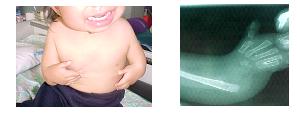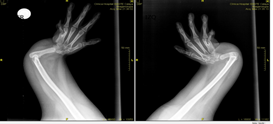Report of a Case of Thrombocitopenic Syndrome with Radius Aplasia with a 16 Year Follow up in Celaya, Mexico, and Review of Literature
Article Information
Raúl Puente1*, Paredes Rogelio4, Daniela Rico Medina2, Verónica Guarner-Lans3, Oscar Emanuel Grimaldo2
1Medical Diagnostic Center of Celaya, Mexico
2University of Celaya Pan-American Highway School of Medicine, Rancho Pinto, Mexico
3Department of Physiology, National Institute of Cardiology “Ignacio Chávez”, Tlalpan, Mexico
4Department of Hematology, National Institute of Pediatrics, Insurgentes Cuicuilco, Mexico
*Corresponding Author: Raúl Puente, Medical Diagnostic Center, Celaya, Mexico
Received: 16 March 2019; Accepted: 25 March 2019; Published: 01 April 2019
Citation:
Raúl Puente, Paredes Rogelio, Daniela Rico Medina, Verónica Guarner-Lans, Oscar Emanuel Grimaldo. Report of a Case of Thrombocitopenic Syndrome with Radius Aplasia with a 16 Year Follow up in Celaya, Mexico, and Review of Literature. Journal of Pediatrics, Perinatology and Child Health 3 (2019): 044-048.
Share at FacebookAbstract
There are numerous published works on thrombocytopenic syndrome with radius aplasia. Most of them refer to cases or families with several affected individuals without giving them follow-up. Here we report the follow up of a patient with the syndrome. The clinical manifestations found in the patient are not classical since thrombocytopenic syndrome with Radius Aplasia does not usually have bilateral agenesis of radius and ulna at birth as is shown in this case. In addition, the musculoskeletal manifestations in this patient were present 16 years afterwards. Therefore, the phenotypic expression of this syndrome in the present case is of great interest.
Keywords
Thrombocytopenia, Radius aplasia, Radius agenesis, Girl
Article Details
1. Introduction
The thrombocytopenic syndrome with radius aplasia (TRA) is a very rare congenital malformation syndrome characterized by bilateral radius aplasia and thrombocytopenia. It affects less than 1 per 100,000 live births, without there being differences between sexes [1]. The TRA syndrome is characterized by bilateral absence of the radius, but patients have thumbs (main characteristic that differentiates the TRA syndrome from other disorders that also show radius aplasia, thrombocytopenia and other features, such as skeletal and cardiac anomalies. In the most severe cases, patients show anomalies in the ulna, humerus and phocomelia. The lower extremities can also be affected (dislocation of the patella and/or hip, absence of tibiofibular joint and phocomelia of the lower extremities) [2-5]. Hypomegakaryocytic thrombocytopenia is present in all cases. The individuals having more affections present hematomas at birth, petechiae and can show severe hemorrhages (gastrointestinal and, rarely, intracerebral) during the neonatal period and the first years of life. During childhood the number of platelets gradually increases and, in adulthood the platelet count is almost normal or completely normal [6].
2. Case Report
We report the case of a patient that was given birth at term being the product of a third pregnancy of the mother. There were no complications during pregnancy. Antenatal care was carried out at the IMSS, Celaya. The delivery was eutocic, with birth weight of 3.2 kg, height: 48 cm, apgar of 8-9. The mother commented that the newborn was sent to the IMSS clinic in León, Gto, due to severe thrombocytopenia, without active bleeding. For this reason, she was transfused platelet concentrates twice. The patient was fed maternal breast milk. The immunization schemes were complete for the age and therefore, she was discharged from the pediatric service.
The patient was referred to the private pediatric clinic of the municipal DIF at the age of 1 year 9 months for assessment. Hematological cytometry was performed, finding a hemoglobin level of 12.3, a hematocrit of 34.6, eukocytes of 14.100, platelets of 62.00, average platelet volume of 6.9, segmented cells of 52%, and lymphocytes 48%. A bone marrow aspiration was performed, the red and white series were found to be normal, and the platelet series showed a reduction in the size and number of megakaryocytes. The thrombopoietin levels were of 120 pg/ml. The physical examination revealed a wide and high forehead, normal ears and pharynx, well ventilated lung fields, a precordium with heart sounds, a soft abdomen without visceromegaly and upper extremities with no bilateral forearms. No petechiae or ecchymosis were observed nor evidence of active bleeding (Figure 1).
Prednisone treatment was started at a dose of 1 mg/kg/day; however, during the following two weeks the amount of platelets was increased. Since the thrombocytopenia was asymptomatic, it was decided to suspend the medication and only observe the hematological evolution with blood cytometry. Monthly tests were done and changes were found in the platelet count varying from 54,000 to 89,000. Therefore, the patient remained stable and was asked to return every 6 months for evaluation. The case received a follow up of 16 years, during which time the presence of musculoskeletal abnormalities was striking. She showed wider thumbs than those present in healthy subjects; ulnar deviation of the thumbs, both in the metacarpophalangeal (MCF) and interphalangeal (IF) joints; the thumbs flexed towards the MCF joints and therefore were held within the palms of the hands (Figure 2).
3. Discussion
In the present case, the bilateral absence of radius with the presence of both thumbs was demonstrated. The presence of the thumbs differentiates this case from patients with Fanconi Syndrome. It has been shown that the length of the upper limb can influence the functionality of the thumb [6]. These types of defects are divided into 3 groups: a) Patients have mild defects, radial aplasia with varying degrees of ulnar and humeral hypoplasia; this group include most cases (71%). b) Variable limb shortening is observed, humeral hypoplasia and little development of the humeral circumference with a decrease in the length of the upper part of the trunk is present; this group includes 18% of cases; and c) Cases in this group have severe ulno-humeral shortening and phocomelia and therefore this group includes the more affected patients [7]. Another aspect that has been studied in patients with TRA syndrome is the thumb. It is known that the thumbs are invariably present, but it has been shown that they do not have the normal functionality. They also have diverse appearance. For all the above, the phenotypic expression present in this patient is very striking.
4. Conclusion
There are numerous published works on the TRA syndrome; however, most of them refer cases or families with several affected individuals and they do not report the follow-up of the patients. We have not found many papers that describe bilateral agenesis of radius. We consider that the frequency of bilateral radius agnesia is minimal, and we cannot rule out that in certain cases with absence of radius, or other severe limb reductions, the syndrome might have been present. The clinical manifestations of the syndrome are well known, showing a wide spectrum of associated defects that affect the face, heart, lower extremities and even the urogenital system. It is important to bear in mind that although there is complete and bilateral absence of the radius in this syndrome, the thumb is always present. This is an essential feature for the differential diagnosis, since if a case occurs where there is an absence of the thumb, it is necessary to look for other possible diagnoses different from TRA.
References
- Gross H, Groh C, Weippl G. Kongenitale hypoplastische thrombopenie mit radius-aplasia, ein syndrome multipler abartungen. Neue Oest Z Kinderheilk 1 (1956): 574.
- Shaw S, Oliver RAM. Congenital hypoplastic thrombocytopenia with skeletal deformities in siblings. Blood (1959): 374-377.
- Hall JG, Levin J, Kuhn JP, et al. Thrombocytopenia with absent radius (TAR). Medicine 48 (1969): 411-439.
- Hedberg VA, Lipton JM. Thrombocytopenia with absent radii. A review of 100 cases. Am J Pediatr Hematol Oncol 10 (1988): 51-64.
- Fernández Ramos O, Almagro Vázquez D, Ballester Santovenia JM, et al. Púrpura amegacariocítica congénita con aplasia de radios. Sangre 21 (1976): 366-374.
- Hernández Bello A, Giralt M, Marco Tello A, et al. Trombocitopenia amegacariocítica congénita con ausencia de radios. Sangre 21 (1976): 175-180.
- Ortega Martos L, Moltó Ripoll L, Cañizares García JM, et al. Púrpura trombocitopénica congénita y aplasia bilateral de radio. Arch Pediat 28 (1977): 67-72.
- Mazo E, Echeverría J, Francisco MC, et al. Púrpura trombopénica amegacariocítica congénita con aplasia radial bilateral y reacción leucemoide. Sangre 23 (1978): 479-483.
- Méndez A, Díaz M, Doménech E, et al. Síndrome de trombocitopenia y aplasia radial (TAR). Acta Med Tenerife 41 (1980): 49-54.
- Aledo AG, González M, Olier A, et al. El síndrome de trombopenia-aplasia radial (TAR). An Esp Pediatr 16 (1982): 82-87.
- Velásquez B, Duro E, Lemus A. Síndrome de trombocitopenia y agenesia del radio (TAR syndrome). Acta Pediatr Esp 42 (1984): 342-345.
- Sanchís Calvo A, Beltrán Marqués M, Valverde Mordt C, et al. Síndrome TAR (Trombocitopenia y aplasia radial). An Esp Pediatr 41 (1994): 415-418.
- Anyane-Yeboa K, Jaramillo S, Nagel C, et al. Brief clinical report: Tetraphocomelia in the syndrome of thrombocytopenia with absent radii (TAR syndrome). Am J Med Genet 20 (1985): 571-576.
- Hall JG. Syndrome of the month: Thrombocytopenia and absent radius (TAR) syndrome. J Med Genet 24 (1987): 79-83.
- Jones KL. Smith’s recognizable patterns of human malformations. (4th), Philadelphia: W.B. Saunders Co. (1988).
- McKusic VA. Mendelian Inheritance in Man: Catalogs of Autosomal Dominant, Autosomal recessive, and X-linked Phenotypes. Medline Edition (1994).
- Martínez-Frías ML. Primary midline developmental field. I. Clinical and epidemiological characteristics. Am J Med Genet 56 (1995): 374-381.
- Martínez-Frías ML. Developmental field defects and associations: epidemiological evidence of their relationship. Am J Med Genet 49 (1994): 45-51.
- Martínez-Frías ML, Félix Rodríguez V, Hernández Ramón F y cols. Síndromes con defectos del tubo neural: Análisis epidemiológico en España. An Esp Pediatr 45 (1996): 276-280.
- Martínez Frías ML, Prieto Valiente L, Bermejo Sánchez E, et al. Estudio del peso al nacimiento sobre una población de niños sin defectos congénitos. I. Curvas de percentiles del peso por edad gestacional. An Esp Pediatr 33 (1990): 12-15.
- Van Haeringen A, Veenstra F, Maaswinkel-Mooij PD, et al. Intermittent thrombocytopenia and absent radii: Report of a patient with additional unusual manifestations. Am J Med Genet 34 (1989): 202-206.
- Ceballos-Quintal JM, Pinto-Escalante D, Gongora-Bianchi RA. TARLike syndrome in a consanguineous mayan girl. Am J Med Genet 43 (1992): 805-807.
- Schnur RE, Eunpu DL, Zackai EH. Thrombocytopenia with absent radius in a boy and his uncle. Am J Med Genet 28 (1987): 117-123.


